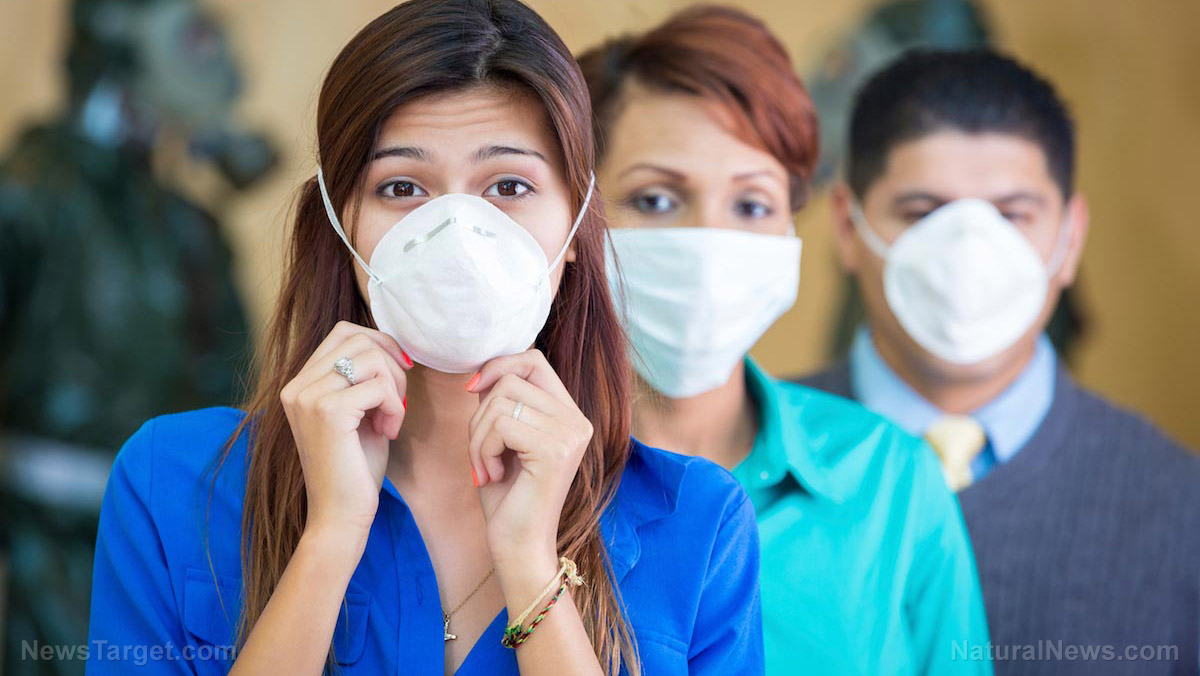(Article by Dr. James Lyons-Weiler, PhD, republished from WorldMercuryProject.org)
This type of immunity exists within populations to varying degrees depending on the number of individuals who are immune to the infectious agent. Other factors that influence the spread of pathogens include attributes of the infectious agent, attributes of the vaccine, the route, mode and rate of transmission of the infectious agent, the lethality of the infectious agent, and the diversity of types of the specific pathogen for which immunity is sought.
Regardless of whether immunity is achieved via a vaccine, or via natural infection, the total percentage of individuals who are immune can have an effect of slowing down the rate of spread of infection via natural transmission. Herd immunity is sought, in part, due to concern over individuals who are immunocompromised because they are more likely to contract a circulating pathogen in a population in which the infectious agent is relatively free to spread. It is generally thought that there is an inverse relationship between the percentage of a population that is immune, and the chance that a person who is not immune will come into contact with an individual who can transmit the virus.
Either through natural immunity or through vaccination, sufficient herd immunity can, in principle, bring the rate of transmission of an infectious agent to zero, with immune individuals collectively acting as a barrier to the spread of the infectious agent, until it “burns out.” Unless there is a natural reservoir, herd immunity can be a factor that can contribute to the eradication of infectious agents.
In most mainstream descriptions of herd immunity, the contribution of natural immunity is diminished, or not even mentioned, as the individuals are counted as part of the percentage that have been infected. However, the statistic of interest to epidemiologists tracking the spread of infectious disease is the number of new transmissions, so any individual who has recovered from a previous infection, and who is now immune, most typically does not represent a source of potential new infections.
Individuals who have natural immunity, whether via natural infection, or passive immunity in babies who acquire their mothers’ antibodies, all contribute to a reduction in the rate of occurrence of new transmissions. Some viruses and bacteria however, are inherently capable of re-infecting, either because they rapidly evolve (such as the cold virus, or the influenza virus), or there are many types (such as HPV), or because they result in a poor or non-specific immune response.
Vaccines: Efficacy and Injury
Efficacy of specific vaccines vary, and thus a difference exists between the rate of vaccination and the rate of immunization. This difference is one of the reasons why there can be no one fixed rule for percentage of vaccination rate required to achieve sufficient herd immunity. Other factors include:
- the incidence of the disease at a given time
- variation among vaccines in terms of the period of immunity (the period for which a vaccine confers protection against the wild-type)
- the nature in which vaccination is conducted.
When only an identifiable segment of the population is at risk of acquiring an infection, such as is the case for Hepatitis B, targeted vaccination can be an effective means of control. The determination of the benefit of widespread vaccination for any vaccine must consider not only the ability to protect those at risk, but also the downstream costs due to vaccine injuries. The calculations used to bring a Hepatitis B full-population (mass vaccination) program forward did not include any explicit determination or estimation of the cost of Hepatitis B vaccination beyond the cost of the vaccine units themselves.
Obviously, a vaccine that imparts a higher risk of injury than is relayed to the public, either due to weak, poor, or fraudulent vaccine safety science, will cause a manifestation and realization of that risk, which then will be shared across news media outlets (1980s-late 1990s) and, with mainstream media afraid of losing advertising revenue from direct-to-consumer marketing, via social media outlets (late 1990s-present).
For example, widespread vaccine injury reports by thousands of parents including immediate (same or next day) symptoms such as seizures, screaming, head-banging, loss of verbal communication, etc. have contributed to vaccine hesitancy. This will reduce vaccine uptake, thereby limiting the ability of that vaccine to contribute to herd immunity. Such has been the case now for many vaccines currently on the CDC vaccination schedule. The cause of the inability of the vaccine to contribute to herd immunity in these cases results from clearly misleading information on the safety of the product, magnifying distrust.
Some vaccines come with warnings that those receiving the vaccine should not go near infants who have not been vaccinated against that infectious agent. This is the case of vaccines against the Bordetella pertussis bacterium, which causes whooping cough (a treatable respiratory disease).
Pertussis is also an interesting infectious agent with respect to the concept of herd immunity. According to the CDC, individuals should be vaccinated two weeks prior to being near a newborn. Consider then this quote from the CDC:
More than 95 percent of U.S. children receive three or more doses of pertussis vaccines, while less than 1 percent are completely unvaccinated. Because of this, we usually find that most pertussis occurs among vaccinated people. This does not mean that the vaccine doesn’t work, it just means that most people are vaccinated but protection wears off.
And yet the herd immunity threshold score (the target percentage) allegedly required to acquire herd immunity is between 88% and 93%. The difficulties in expecting herd immunity with vaccination against B. pertussis were known back in the 1990s (Fine, 1993):
The cyclical pattern of pertussis provides a classic example of mass action dynamics…. Consideration of age-dependent transmission has suggested a slightly lower estimate, 88 percent, assuming no waning of immunity…. Given that these herd immunity estimates are higher than most estimates of the protective efficacy of a complete course of pertussis vaccine… and that there is evidence of waning vaccine-derived protection… it appears that eradication of this infection is not currently possible by childhood vaccination alone.
Vaccination of those most at risk of being infected is considered to be the most efficient use of herd immunity. These strategies are sometimes called “bubble” or “ring” (around an outbreak) and cocoon (around an individual) vaccination. The CDC recommendscocoon vaccination for infants for pertussis, leading to new vaccination of individuals who will be near the infant shortly after birth with the DTaP/TDap vaccine. This recommendation persists in spite of the findings of epidemiologists who reported in 2012 that to prevent one infant death, one million parents would have to be vaccinated. Fear tactics—such as the Glaxo Smith Kline ad featuring a new grandmother, supposedly not recently vaccinated with TDap, turning into a wolf—are used to aggressively promote the cocooning strategy. Nicola Klein, a pediatrician and vaccine researcher who led a recent Pediatrics study on vaccinations for whooping cough stated, “I haven’t seen any studies that show a strong protective effect from the cocooning strategy.”
Vaccine Failure
The vaccination paradigm holds that a specific percentage of vaccinated in a population will bring about herd immunity fails at 95 percent in part because people who are vaccinated lose their immunity. With acellular pertussis, the immunity is lost fairly quickly; one study in 2005 found that adolescents who were schedule-compliant for pertussis vaccination only had 73% effectiveness within one year of the final booster, and that the effectiveness rate dropped to 34% within two to four years. Compared to natural immunity, which lasts four to 20 years, the pertussis immunization program cannot be expected to contribute to herd immunity as well as vaccine proponents would have us believe.
Dr. James Cherry, in a commentary accompanying the Acosta et al. study, found the results, which he calls “vaccine failure”, “disappointing” and pointed out that case-control studies tend to inflate efficacy. He attributes the failure of the TDap and DTaP vaccination program to five factors:
- waning immune responses
- a change in the typical immune response in vaccine recipients
- insufficient antigenicity of the vaccine due to missing proteins that would cause longer immunity as in the natural infection
- improper formulation of the antigens that are in the vaccines
- a stronger response of the original vaccine components than to new epitopes in the later vaccine
Vaccines other than the TDap/DTaP have been developed with high efficacy. Why have these not been brought forward? Combined vaccines have caused gridlock on improvement in terms of both safety and efficacy, and this gridlock has lead ACIP and CDC to adopt unsafe strategies. Unfortunately, the failure of the proposed ten-year booster TDap program resulted in calls for vaccination with TDap during pregnancy—each pregnancy.
For a vaccine to be administered to pregnant women without adequate safety data is, in my view, nothing short of medical malpractice. Pertussis vaccination during pregnancy was actually put into policy with zero safety data. The use of TDap during pregnancy was recommended by the CDC in 2013—before, even as they admitted, sufficient safety testing was available. The subsequent and few vaccine safety studies conducted for TDap during pregnancy focused primarily on maternal outcomes, and have not properly accounted for fetal deaths (e.g., excluding cases of spontaneous abortions). Maternal immune activation is especially problematic for brain development.
In a review of one study in its recommendation, the CDC reported that fever was observed in 2.4%–6.5% of recipients of a TDap booster (indicating increased risk of neurodevelopmental issues, per maternal immune activation), and while those rates were similar to controls, they noted that, “Safety data on use of Td during multiple pregnancies have not been published,” and yet they still recommend TDap in each and every pregnancy.
And herein we see the same logical fallacy that CDC has been using since 2004 to have vaccines approved. The use of an absence of evidence as evidence of absence belies an approval bias that reaches outside the realm of science.
In a study earlier this year, Perry et al reported that 3% of women who received TDap during a pregnancy were not likely to accept another TDap during subsequent pregnancies due to responses to the first dose. However, they also noted that maternal reactions following receipt of TDap are common: two-thirds of the study population had noteworthy negative reactions.
ACIP Wants Three Doses of MMR? What For? 19% Efficacy?
In their anti-trust case against Merck, two whistleblowers have asserted that the actual efficacy of the MMR vaccine against the wild-type mumps virus may be as low as 10%. ACIP recently recommended a third dose of MMR to help stem the growing number of mumps outbreaks across the country. For over a decade, mumps outbreaks worldwide have involved—almost exclusively—vaccinated individuals. In an article reviewing the Merck fraud case, Dr. Paul Offit, MD is quoted as “believing” that all young people should be required to get a third MMR dose before entering college. This “belief”, like ACIP’s “belief” that TDap would be safe during pregnancy, is not science-based.
Based on Merck “science,” MMR is claimed to have a two-dose “efficacy” of 80-85% (“efficacy” is in quotes because this is for the vaccine strain, not the wild type). If the whistleblowers’ allegations are correct, under a naïve model in which repeated vaccination increases immunity in the previously vaccinated at the same rate as the unvaccinated (a dubious but best-case scenario), my calculations tell me that the expected population-wide efficacy of MMR against wild-type mumps after three doses is 14.5%. To achieve the reported immunity (85%), individuals would have to receive a stunning 14 doses of MMR. If the single-dose efficacy is 68%, four doses are needed to achieve 85% overall efficacy. Note that even this falls short of Merck’s goal of 95% efficacy to achieve herd immunity. Clearly, if TDap/DtaP is a failed vaccine, MMR is an absolute blunder.
Theory vs. Reality
So, what have we learned about herd immunity from admitted failures such as the TDap/DTaP vaccination program and ongoing mumps outbreaks within vaccinated populations? A meta-analysis in 2015 estimated that assuming 85% efficacy, in every additional year after the last dose of DTaP, the odds of infection increased by 1.33 times and that only 10% of children vaccinated with DTaP would be immune to pertussis 8.5 years after the last dose. Reviewing last year’s Harvard mumps outbreak and the current outbreak at Syracuse University, nearly all the students diagnosed with mumps had been “properly vaccinated” against mumps with the MMR. Given that the only solution offered to us from the CDC is more boosters, I would say that we have not moved or improved in artificial immunization—at least against B. pertussis or mumps—in decades. There are calls for lifelong adult boosters against pertussis to “increase herd protection” as if that is still (or ever was) a viable concept when considering pertussis.
The US leads all industrialized nations in the rates of deaths of infants on the first day of life. Starting in 2011, there were more fetal deaths than infant deaths in the United States (National Vital Statistics Report, CDC), and the rate of maternal death during pregnancy is skyrocketing, beyond all western countries. One study in the Lancetreported a rate of 26 deaths per 100,000 pregnancies in the US.
We have also learned that the vaccine industry, including the CDC, will continue to allow society to expend time, energy and resources on demonstrably failed vaccine programs, ambivalent to the risks of adverse events associated with each and every vaccine, and that they will desperately try to move the goal post of performance, or ditch their vaccination efforts onto another unsuspecting segment of the population without sufficient safety testing.
Read more at: WorldMercuryProject.org
Please contact us for more information.























